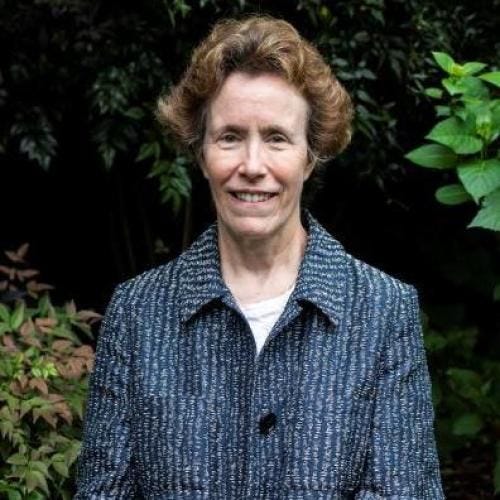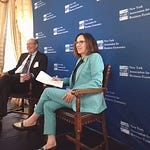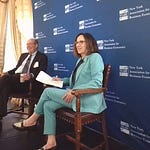Ellen Meade spent 25 years at the Federal Reserve in key roles at the Board of Governors puncuated by 12 years in academia, the path she continues on now as a research professor in economics at Duke University.
Now in particular it is Ellen’s work in her second stint at the Fed that is putting her in the spotlight. In 2018 she was appointed to be Special Adviser to the Fed Board of Governors and then Vice Chair Richard Clarida, as well as Senior Adviser in the Division of Monetary Affairs.
Apropos to the issues being so closely examined by the Fed now, from 2011-2021 she worked primarily on monetary policy and communications and played a key role in the Federal Reserve’s new framework for monetary policy and the Fed Listens initiative in 2019 and 2020 that laid the groudwork for the changes made when this irst-ever framework review was completed.
The challenge now is for the Fed to determine which changes made in the 2020 review may have helped to intensify if not cause the cause the surge of inflation during those pandemic-ridden years. This is the purpose of Fed’s second-ever framework review as it conducts its 2025 “Review of Monetary Policy Strategy, Tools, and Communications.”
Ellen was among the many current and former Fed officials and their global central bank counter parts that gathered at the Fed Board a week and a half ago at the Second Thomas Laubach Conference for two days of discussion and even debate on what to do - and not do - next.
When we spoke, she masterfully set the stage for how the first Fed framework meeting was where the Fed chair Ben Bernanke got the Fed’s 2% inflation target estabilished publically and officially. And how he may have hoped but was unable to convince his colleagues that over time they should issue after every meeting a policy statement that included an FOMC forecast on where the economy and monetary policy were likely to head.
Ellen also shares her ideas on how now, in 2025, the Fed could revise the “Dot Plot” it issues four times a year where each FOMC member gives a forecast for GDP, unemployment. and inflation on which they base their individual forecasts for the path of the federal funds rate.
So dive in and hear what she has to say. If you are a novice Fed watcher, maybe even an investor who is wondering what all the Framework Review hoopla is about, when you finish listening to her, you will have an insider’s view on what the key issues are and why they are important to outsiders too.
Fed Framework-a focus on Communications 00:02:05:00
I think the framework as such has so many facets to it and the review itself has so many facets to it. It's not you know, the ultimate product is the revised statement on longer run goals and monetary policy strategy. On the inside we call that consensus statement. You know, that's the ultimate goal. But there are many, many pieces to generating that ultimate goal along the way. You know, there's a lot of staff work and memos and a research conference like the one you and I attended a week ago. There's FOMC discussions of the topics since the 2020 since the 2019 review. There's Fed Listens. So there are many different components. I think the one that I'm most fixated on right now is a discussion around communications and what should come out of that.
Communication the step child of the 2020 revision 00:03:10:
You know, the review is formally titled Our Review of Monetary Policy Strategy Tools and Communications Framework. A lot of people have said that in the 2019 2020 review, we really didn't do much with communication. You know, we did a lot with the consensus statement that gets a lot of attention from all these authors you're mentioning. We didn't do a lot with communications.
The Dots and SEPS: a long history 00:04:27:19
So policymakers have actually been submitting projections since 1979 and Congress required in the revision to the Federal Reserve Act in ‘78 that the Chair testify twice a year monetary policy report to Congress, and that the Fed produced a report that accompanied that testimony. And those forecasts were originally part of the report that started in, I think it's July ‘79, that the forecasts started appearing.
Evolution of the SEPS 00:05:37:12
Bernanke took these forecasts that were long part of the monetary policy report and said, what if we did them four times a year rather than twice a year? What if we did them with all policymakers participating on certain variables unemployment, inflation, GDP growth, interest rates, and everybody submitted their best assessment that, you know, the most likely outcome for the economy over several years based on their own individual assumptions about appropriate monetary policy, not Ben Bernanke's assumptions, not things that committee is likely to vote on? They started doing that in October 2007. They didn't really add an interest rate. The interest rates had never been part of it. They put that in in January 2012. That's when we got this thing called the dot plot. Right. And we look at where the Fed funds rate is expected to go by all these people over the next three years and in the longer run.
A step toward the Fed reaction function 00:07:14:13
Bernanke saw this as a key piece. He still sees it as a key piece for what central bank should produce to guide the public right about policymakers views their monetary policy reaction function the way they're going to respond. And I think he was using the SEPS as a waystation to getting to a committee forecast.
Fed aspirations…00:07:48:07
Central banks, other central banks, as was discussed last week, the Swedish central bank, the Bank of England, the ECB, prominent central banks have forecast that the committee that the central bank produces and in some cases their products of the committee. You know, and I think that Bernanke hoped that the Fed would be able to produce a forecast maybe similar to what Sweden has or the Bank of England has.
The SEPS , Dots, are flawed 00:11:07:10
<Bernanke> made a big push for making these SEPS, and the scenarios more definite, but…would this mean you would take the median dot, for example? That's how the thing everybody talks about coming out of this and maybe this SEPS and looking at the DOT plots, they look at the median dot and then people sort of take that as, I guess, that's kind of the average of what the Fed's looking for. So that's what we're going to expect this year. You know, it was probably like two rate cuts, right. I think we're talking about a few things all mixed together. Right. Here's what the SEPS is today, which everyone agrees has flaws. Okay. We could get into those flaws, but it has flaws. It does produce this median dot. Some people like Don Kohn, I think, Bernanke, would probably agree with this statement that there's too much weight market participants, perhaps journalists put too much weight in the medians as being the right answer for what the committee is likely to do.
How to diffuse the focus- 00:12:36:02
Too much focus on one particular thing as opposed to the broad landscape. That includes a lot of uncertainty, a lot of risks. And so you're only, you know, that that dot is the thing you think is most likely, but it doesn't mean you think other things are completely unlikely. Right? Right. So maybe your most likely outcome is something you judged to be 35% likely. Well, okay, what about the other 65%? It could be divided up across a number of other things you think could happen. So by putting out just one dot, it, it provides too much of a view of certainty around that particular thing. So that’s the point of putting out alternative scenarios and highlighting different sorts of things that could happen is to communicate that uncertainty.
The first framework 00:13:39:04
In 2012, remember what the 2012 statement did, it wasn't really a framework review. It was the first framework. Right. And it was an articulation of the goals and how the committee saw them and what the committee was willing to write down about how it thinks about achieving those goals of maximum employment and 2% inflation.
The tortured path to a consensus FOMC forecast 00:15:21:12
Okay. Yeah. Sounds good to me. So. So you have 19 policymakers and what if most of them were unwilling to agree with it and they all lodged reservations? That looks a lot like the SEP, right? Just so they could never quite get to this idea of being broadly in consensus, which I think is the term that the person from the bank of England who was at that conference last week, they don't have to agree with every piece of it, but they're broadly in agreement with it.
Staff forecast 00:16:52:18
Currently, the staff forecast is objective. An independent forecast doesn't mean in what way. It's independent of the policy makers. This is, yes they do their staff economics in front of the FOMC, but they react first. And it's it forms a baseline for the FOMC. It doesn't mean that every policymaker likes it or agrees with it.
Beige and Teal 00:19:54:12
The Beige Book, as you just mentioned, is collected by the Reserve banks from their districts. Right. And that's published three weeks before the FOMC meeting that the Teal Book is the staff forecast and assessment of a variety of elements around the staff forecast financial sector developments, monetary policy rules, all sorts of things go into the Teal Book and it's given to policymakers, about ten days before the meeting so that they have time to read it and see what staff is thinking. the Reserve Bank presidents have their own staff, so those staff can read the book and say, you know, I don't agree with this. And the president can have a full debate with his own staff around what is good or bad about the book. But one thing that's really good about the Teal book is that it provides a baseline for the discussion about the economy with the most up to date information at the time that it's produced, which is about ten days before the meeting.
The staff forecast 00:21:46:18
You know, the staff's not thinking, oh, if I were chair, I would do this with the federal funds rate. The staff is trying to pick some sort of objective way. And so they'd probably use a sort of form of a short falls rule, and we don't need to get into that. But some form of a rule in generating the path for monetary policy. And then they're forecasting the economy around that and using alternative scenarios, all Sims, as they're called. Policymakers might see two, three, four alternatives simulations about what if tariffs are really heavy, what if tariffs are really light, what if this or that or the other thing in in the to your book. And so I think the best thing from a former staff perspective is how the committee gets a completely independent assessment that is free of political concerns. So I think when Bernanke makes this wonderful suggestion, when the consensus statement exercise failed, and Bullard said, well, if the committee can't produce a forecast, let's release the staff forecast. I think the problem with that is the staff forecast today is different than what the staff forecast would be two years from now after it's being released to the public, because by then, you know, the policymakers, the Fed chair would say, you know, I'm not really that comfortable releasing a staff forecast that has big tariff increases in it.
Staff forecasting dilemmas- 00:26:09:12
We heard the Bank of Canada person say at that conference last week that, you know, they didn't have a baseline scenario in their last baseline forecast in their last release because they didn't know it was too uncertain. So they had a good, you know, a good tariff scenario and a bad tariff scenario. And you could say that in times that looked to be particularly difficult and uncertain and you could add on to it politically fraught, that the Fed shouldn't have a baseline forecast because what's the baseline forecast? It's the most likely outcome, right? It's the modal outcome. So maybe it's too difficult to produce that modal outcome. And you have a series of possible studies.
Link the SEPS element forecasts 00:29:39:04
So right now, when the forecasts come out, you get a bunch of forecasts for peak growth, a bunch of forecasts for inflation, unemployment, interest rates year by year by year. But you don't know which individual, you know how those forecasts link, right? So the person who wrote down a funds rate of 4%, you don't know what that person's GDP growth was, right? Right. This year, next year, the following year for inflation or unemployment, you could link those things together so that you put out the forecast. But now I know that ‘individual A’ because we wouldn't name them, right? ‘Individual A’ put out, you know, GDP growth for these years looking this way, unemployment, inflation and so on. And then you could understand better what person's perspective, right? So that's something that has come up in the past and been dismissed inside the Fed. I think, you know, there's quite a bit of agreement that now would be a good time to do it, that that would be, you know, if you're not going to throw away the SEP or downgraded to replace it with something else, now would be a good time to do something like that.
Release dealer survey forecasts 00:31:43:21
Another thing that's come up, you know, the New York Fed runs its surveys of primary dealers and market participants before each FOMC meeting. And if you look at those surveys, the surveys that they conduct, when they ask, say, about GDP growth, they ask the the respondents to the surveys provide information on their distributions. So what's the percent chance that you think GDP growth is going o be below zero or between zero and one and a half and one and a half and three to happen, you fill in a distribution of outcomes. You could convert the SEPP to something like that where you then see it gets more complicated. It would be kind of complicated both for the people filling it out and also for what's the best way to present this information to the public.
A balance sheet forecast? 00:33:15:09
Right. So that's been suggested. That's even could you you know, sometimes it's been suggested last time in 2019, 2020, we talked about even maybe adding the balance sheet as a question. The SEP doesn't cover the balance sheet. You're all right. Now, that's not so much Everybody's concerned. Okay. But, you know, you could consider that, too. So those are ways you could tinker with the SEP to make it a more informative vehicle.
What lies ahead…scenarios? 00:34:27:05
We've already seen since the Bernanke report around the Bank of England, Ben Bernanke had been tasked the Bank of England with providing a report on their communications, and he did. And one of the big things he highlighted was alternative scenarios. And since that time, Chair Powell has been providing more information around alternatives in the press conference, not not really detailed, but he's been talking more in that way. I think, you know, it's a time of heightened uncertainty and people understand the need for that, exactly how they're going to do it. I don't know. I don't know whether they would consider the publication of it to a book forecast. But right now with the Bernanke paper from the Conference, the G 30 paper, you know, there's quite a bit of discussion out there by highly respected experts.
Communications! 00:36:14:23
I think that this focus on communication, the strong voices calling for an improvement in the way things are are communicated. And like I said, just it feels like it's it's time.
Ellen E Meade
Duke University
Research Professor of Economics
228C Social Sciences Bldg, Box 90097, Durham, NC 27708
419 Chapel Drive, Box 90097, Durham, NC 27708
Current Appointments & Affiliations
Research Professor of Economics · 2022 - PresentEconomics, Trinity College of Arts & Sciences
Recent Publications
Using Generative AI Models to Understand FOMC Monetary Policy Discussions
Internet Publication · December 6, 2024Full textLink to itemCite
Janet Yellen, Pioneer and Policymaker
Journal Article History of Political Economy · August 1, 2024Full textCite
Impact versus Inclusion in the Economics Profession: Insights from the Papers and Proceedings
Conference AEA Papers and Proceedings · May 1, 2024We examine trends in author representation, research topics, and impact of citations to articles in the American Economic Review and what was formerly its Papers & Proceedings (P&P). Over what we refer to as the P&P expansion period (2 ...Full textCite
Education, Training & Certifications
Princeton University · 1988Ph.D.
Duke University · 1979B.A.














Share this post